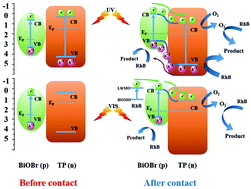A novel p–n heterostructured photocatalyst for the efficient photocatalytic degradation of different kinds of organic compounds under irradiation of both ultraviolet and visible light
Abstract
In this study, BiOBr–titanium phosphate (BiOBr/TP) plate-on-plate composites with p–n heterojunctions were synthesized using a simple, feasible two-step method. X-ray diffraction (XRD), scanning electron microscopy (SEM), transmission electron microscopy (TEM), energy dispersive X-ray spectroscopy (EDX) and UV-vis diffuse reflectance spectrometry (DRS) were used to evaluate the structure, morphology and optical properties of the composites. Rhodamine B (RhB) and ciprofloxacin (CIP) were chosen as model pollutants to evaluate the photocatalytic activity of the synthesized samples under irradiation of both ultraviolet and visible light. The BiOBr/TP composites exhibited much higher photocatalytic activity for the degradation of both pollutants than pure TP. The enhanced photocatalytic performance can be ascribed to the formed p–n heterojunctions between p-type BiOBr and n-type TP, which efficiently reduced the recombination rate of photo-excited electrons and holes. Moreover, a possible photocatalytic mechanism of organic pollutant degradation by the obtained samples was presented in detail.


 Please wait while we load your content...
Please wait while we load your content...